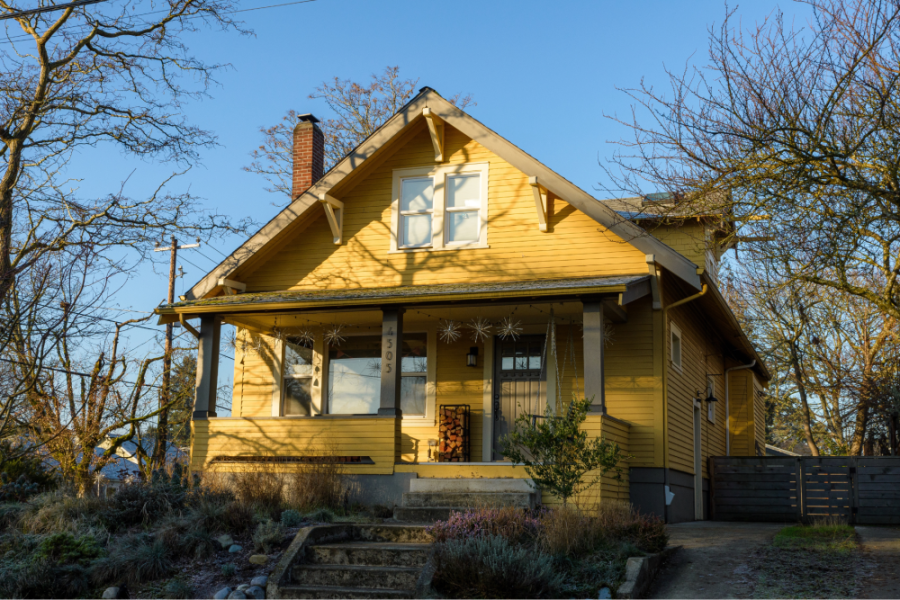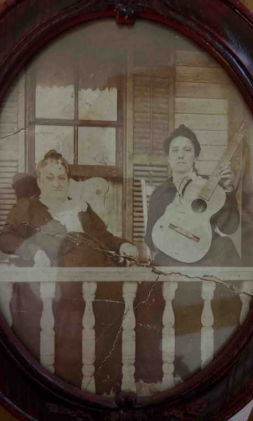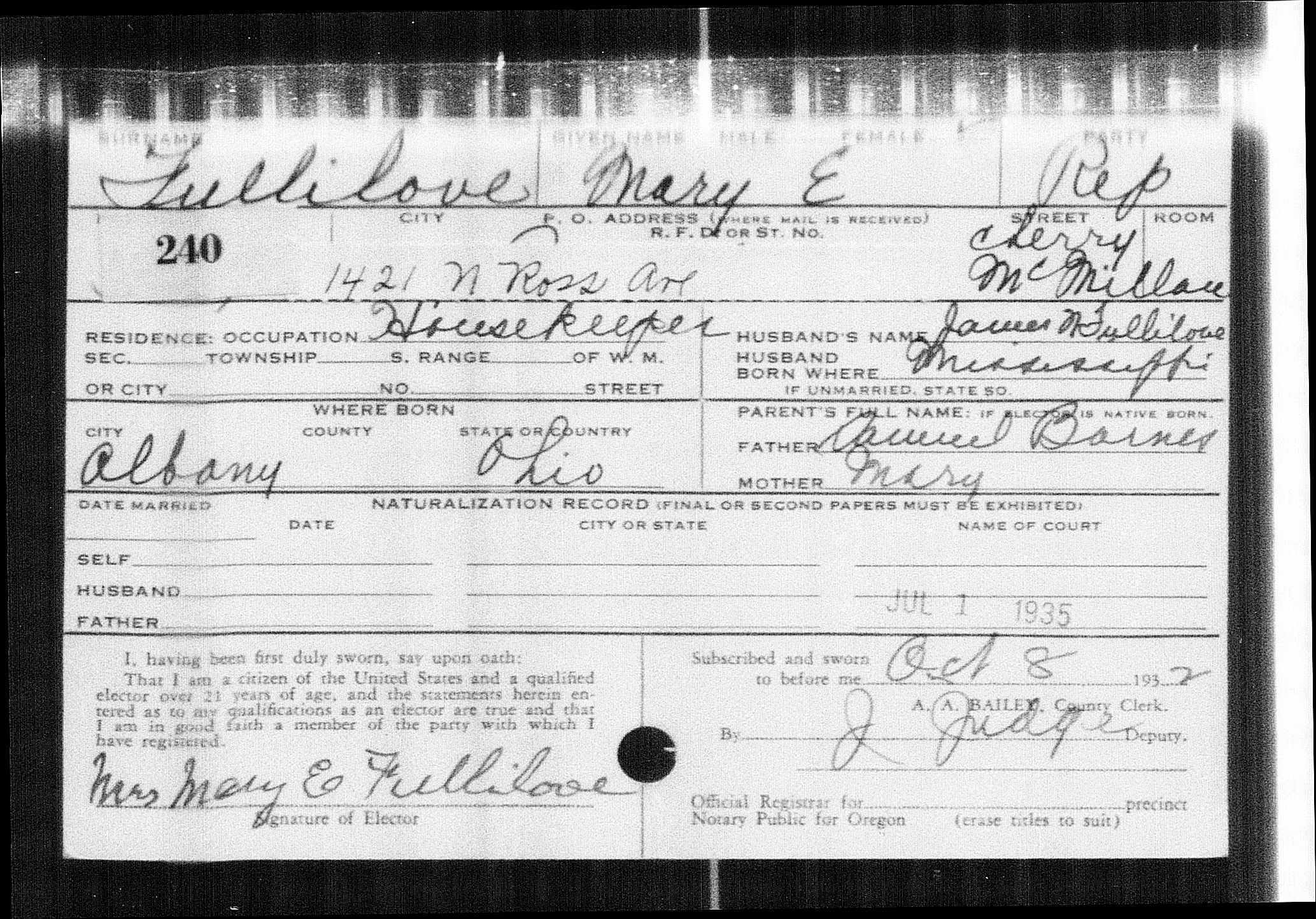
Mary E. Barnes Fullilove
The Forgotten W.C.T.U and Suffrage Trailblazer
by Kimberly Moreland
As the lead research consultant and member of the Albina Preservation Initiative, a preservation project dedicated to bridging the gap between traditional historic preservation and Black history in Portland, we discovered the home of James Nathaniel and Mary E. Barnes Fullilove, who purchased land in 1907 and built their home in 1913 in the King neighborhood.

Pictured Above: Mary E. Barnes Fullilove and her mother, Courtesy of Zona Gardner, great-great-niece of Mary E. Barnes Fullilove
A deeper dive into their lives illuminated this progressive couple, who are both identified as mulatto, dedicated their lives to improving the quality of life for Oregon's small, growing African American community at the turn of the twentieth century. As we celebrate both Black and Women's History Months, Mary E. Barnes Fullilove is celebrated and honored for her contribution to Oregon's temperance movement and Oregon's Black history.
Her early life began in Portsmouth, Ohio, where she was born to Samuel and Mary J. Barnes in Scioto County, Ohio, in 1864. Interestingly, Portsmouth became important in the Antebellum years as part of the Underground Railroad. One of Portsmouth's famous residents, James Ashley, was elected to Congress and wrote the Thirteenth Amendment to the United States Constitution, which abolished slavery in 1865 after the Civil War.
According to the 1880 Census, when Mary was sixteen, the Barnes family lived in Little Rock, Arkansas, where she later married James N. Fullilove, a Portland resident. The couple's marriage date is a bit of a mystery. According to a marriage certificate issued by Pulaski County, Mary E. Barnes married James N. Fullilove in 1883 in Little Rock, Arkansas. According to a Morning Oregon article, the couple was married at the Quimby House in Portland on 1 December 1888. According to the 1910 US census, the couple was married for 21 years, making the marriage date 1889 possibly 1888, depending on when the information was gathered.
Prominent Leader of the LUCY Thurman Temperance Union of WCTU
The Fulliloves’ work advancing and uplifting the lives of African Americans in Oregon and beyond is well documented in the early newspapers. Mary was dedicated to the Women Christian Temperance Union (W.C.T.U.) and one of the founders of the African American temperance union, the Lucy Thurman Temperance Union of the W.C.T.U. The couple's activism, particularly Mary’s temperance and suffrage work, is well documented in early historical newspapers, including the New Age, Morning Oregonian, Sunday Oregonian, Advocate, Oregon Daily Journal, and Portland Inquirer.
The Women’s Christian Temperance Union, a powerful reform group founded back east in the 1870s to diminish alcohol consumption or even abolish its sales altogether in “dry towns.” As an expression of moralism, the WCTU movement overlapped with the abolitionist and suffrage movements. The WCTU thrived in Oregon and had its first conference in 1883. In 1899, Mary became involved in what would become the first organized work among African American women in Oregon when Lucinda “Lucy” A. Thurman, the only African American founding member of the Women Christian Temperance Union (W.C.T.U.) and the third National President of the National Association for Women, visited Portland and stayed in the Fullilove home located on 652 SE Morrison Street.

Pictured Above: Mrs. Lucy Thurman - 3rd from left, Courtesy of Tennessee State Museum
Inspired by Thurman, Mary and a group of Portland women established the Lucy Thurman Temperance Union. In 1899, M.E. Fullilove was introduced to the state convention of 1899 as president of Oregon’s first “colored” union and the new organization was noted as growing and very busy in the New Age. By 1900, young ladies were active in the state W.C.T.U. In 1900, it was noted that Mary was the Lucy Thurman Temperance Union president. The Fullilove family home, built in 1913 and located at NE 14th Street, became the Temperance Union headquarters.
In 1903, Mary served as the W.C.T.U. state evangelist and participated in the 30th celebration of the Temperance Crusade. In September 1908, Mary attended the Multnomah County WCTU annual meeting and shared that the Lucy Thurman Temperance Union had an excellent list of officers, the interest of the pastor, established a young women's branch and a loyal temperance legion for children, In that same year, Mary one of the speakers of the Institute of the Multnomah County W.C.T.U., and spoke on the topic, “Why Temperance Women Should Ask for the Ballot.” In 1910, she attended the 27th Annual WCTU conference in Salem and was re-appointed as Superintendent of the Department of Work Among Colored. Mary traveled extensively throughout Oregon, attending meetings of the W.C.T.U. and reporting on the work of Oregon's African American community. In 1918, she was a speaker at the State W.C.T.U. State Convention, where more than 500 women were in attendance. As a featured W.C.T.U. speaker, she once spoke on “How My People Help People.”
New Direction
The temperance movement pledge of total abstinence was not amendable to all women, and a new group, the Colored Women's Council (CWC), was organized in 1912, and one their first order of business was to raise fund to preserve Frederick Douglass home. In the past, historians believed that the Lucy Thurman Temperance Union evolved into the CWC. However, a 1917 article in the Sunday Oregonian documented evidence of Mary’s continued service to Lucy Thurman Union suggested otherwise. In 1917, the Colored Women's Council formed the state Federation of Colored Women's Clubs. Suffrage Leader Katherine Gray was elected President, and the Lucy Thurman W.C.T.U. was among fourteen colored women's clubs that joined the new federation. A Sunday Oregonian article in 1919 noted that Mary was re-elected president of the Lucy Thurman Union, and the meetings were held at her home every Sunday. Mary also served as an officer of the Federation; at the Oregon Federation of Colored Women 16th Annual meeting in 1933, she was elected the chaplain.
Faithful Religious Leader
In addition to WCTU work, Mary was a devoted member and leader at Bethel AME. According to the 1903 New Age article, Mrs. M.E. Fullilove provided an Anthem and was eventually ordained as an Evangelist. In 1928, the Portland Advocate noted Mary “as one of Portland's best citizens and Christian ladies. She was an ordained minister and “practices” Sunday at Bethel AME.” In 1929, she was appointed as an evangelist for Bethel AME.
Family Life
James N. Fullilove, An Early Civil Rights Leader
Each member of the Fullilove family is an outstanding contributor to Oregon's African American history. James and Mary owned multiple properties throughout SE, NE, and the central city. In 1901, James was among several Portland citizens selected by then Mayor Row to serve on the McKinley Day Reception Committee and greet President McKinley when he arrived at the Union Station. The first edition of the Advocate newspaper on September 5, 1903, noted that progressive businessman James and Mary E. Fullilove moved into their new home on the south side. Landownership among Portland's African Americans was surprisingly commonplace, despite Oregon's black exclusion laws, which, among other restrictions, prohibited real estate transactions for African Americans and weren't repealed until 1926.
James was a barber, crier, messenger, and bailiff for the US District Court. He was active in the Afro-American League, serving on the executive committee as treasurer and president. In 1903, he was described as a popular, progressive businessman, capable and credible by representatives of the Multnomah County African American community, who requested that he put his name on the next Republican tickets for the Legislation.1919, Mary's husband, James, as President of the Afro-American Council, drafted Oregon's first civil rights bill, persuading John B. Coffey to introduce it. The bill called "an act establishing rights in places of public amusements,” guaranteed all citizens equal enjoyment of public accommodations and prohibited the printing or posting of signs indicating that services would be refused to anyone based on race and color. The bill failed, and it would take until 1953 before a public accommodation law was passed in Oregon.
Marion Edward Fullilove, Gifted Entertainer
The couple's son, Marion Edward Fullilove, was born in 1917. He attended Buckman Elementary School, won several singing prizes, became a popular youth singer and dancer, and played the harmonica. A gift he inherited from his mother, who often led solo at W.C.T.U. and Bethel AME events. At 11, he was featured in the Oregon Daily Journal as a “versatile junior whose voice changes are startling and mirth provoking.” In 1929, he was a Journal Junior and mascot for the Portland Buckaroo ice-hockey team. In 1931, at the age of 14, he was featured in the Advocate as a “Sensational 14-year-old Negro Tenor Singing with Ollie Wallace all week at the Paramount Theatre sponsored by the Advocate”. He served as a radio operator in the US Navy during World War II from 1942 to 1945. During boot camp, he served as the master of ceremonies for the Happy Hour Colored Camp and performed at the George A. White Service Center in Jackson County, Oregon. Before his enlistment and after, Marion performed as a dancing entertainer at local Portland clubs, including the Club ACME.

Above: Image Courtesy of Moreland Resource Consulting (MRC), LLC.
Mary’s later years
Mary's husband passed away in 1922. According to his death certificate, he lived in Portland for 37 years, which suggests he arrived in 1885, which is confirmed by a Morning Oregonian notation that he joined the partnership of Ferguson and Fullilove barbershop in 1885. Shortly after his death, Mary relocated from their family home, which was the headquarters of the Lucy Temperance Union, and resided in several different locations. In her later years, in 1926, at 62, she advertised as a teacher providing music lessons, specializing in children, and lived in the present-day Memorial Coliseum area on 421N. Ross Street and her voter registration card confirmed she lived there in 1932. By 1937, the Portland Directory indicated she lived at 4403 NE 10th, and in 1940, her son Marion's draft card lists her as the nearest kin, living in Portland at 4403 NE 10th. A 1944 Oregon Daily Journal article about her son, Marion, indicated that his mother, at 80 years old, lived in that same location, probably her last residence in Portland.
Interestingly, the date of her death is unknown. However, the Fullilove family was fiercely dedicated to the quality of life of Portland's small but growing African American community. Being an ordained minister during her time was quite an accomplishment as a woman. She utilized musical talents, oratory, and leadership skills to benefit and uplift her beloved community. Her leadership and contributions to the suffrage and temperance movements and the faith community paved the way for other African American women reformers and civil rights leaders. Her forgotten journey should be forever honored.
Kimberly Stowers Moreland is a community historian, author and owner of Moreland Resource Consulting. She was the lead researcher behind the Albina Preservation Initiative’s digital exhibit “Hidden Landmarks of Albina's Black Community.” Moreland combines her public sector planning, heritage planning, historic preservation, urban planning, and community development to assist community builders. She utilizes her community history experience to document historic places, people, and events related to Oregon’s African American history.

